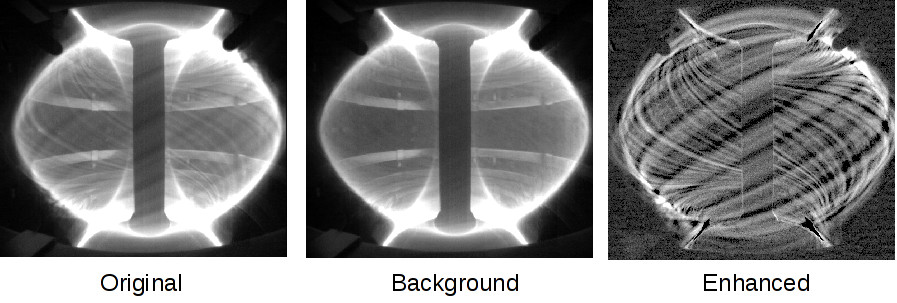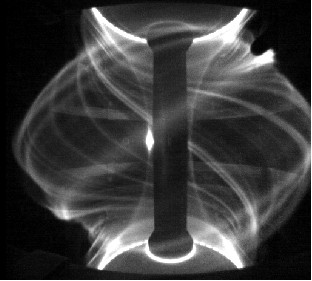Just what is it you do?
June 29, 2012categories: fusion, research
Occasionally someone will ask this, and it's hard to say exactly. I usually mutter something about physics and they'll either go quiet and look a bit shifty, or ask if it's something to do with CERN or Brian Cox. No it's not; I'm just not that emo, although he has done a programme on my area of research: Fusion.
The basic idea of fusion is to generate energy by turning Hydrogen into Helium. The resulting Helium is slightly lighter than the Hydrogen which went into creating it, by about 0.7%. The difference is converted into energy by Einstein's famous equation E=mc^2. Fusion is the process which powers the Sun and stars, and the aim of fusion research is to be able to do this in a controlled way to generate electricity. This research started in the late 1940s, and has turned out to be much more complicated than originally thought or hoped.
Fusion in the Sun uses the most common isotope of Hydrogen, with just a single proton. Around 500 million tonnes of it are converted to Helium every second, in a core which reaches temperatures of 13.6 million degrees C. Unfortunately this isn't enough for generating electricity on Earth; the Sun only produces around 0.3 Watts per cubic meter, less than a candle flame. If we wanted to turn a chunk of the Sun's core into a 1GW power plant, it would need to contain 170 billion tonnes of plasma and occupy more than a cubic mile. To make fusion work on Earth we need to use heavier isotopes of Hydrogen (Deuterium and Tritium) at much higher temperatures than the core of the sun, around 100 million degrees. The amazing thing is that this is now regularly done, and the core of tokamak experiments like JET are the hottest places in the solar system. After more than 60 years of research, the understanding of the fusion process is now good enough to build a full scale experimental fusion reactor: ITER is being built in Cadarache, France, and is designed to run for a few hours whilst producing 500 MW of fusion power for a heating input of 50 MW. The aim of this experiment is to test that our understanding of the plasma physics is correct, and to develop the materials.
Now that we've put a sun in a box, the challenge is to build a box which will last long enough to make it economical to build. The issues are the neutron irradiation of the materials, and the heat loads from all this power being produced: At the edge of the plasma where it meets the walls of the machine the plasma must be controlled so that it doesn't damage the surfaces. This means keeping the power onto surfaces below a few 10s of MW per square meter, similar to the loads on jet engine blades or rocket exhausts. Designing a machine which can do this means understanding, or at least being able to predict with some accuracy, how plasma moves around near the boundary and interacts with gas and materials. Unfortunately, this motion is turbulent, with complicated filaments of plasma erupting from the plasma edge and moving around at several kilometers per second. They can be seen with fast cameras, for example in the picture below from the Mega-Amp Spherical Tokamak (MAST) in Culham, UK.

On the left is the original image, where you can faintly see the filaments. This has been separated (using a code I wrote, Spiceweasel) into a smooth background and the filaments shown on the right. This is what I work on much of the time; Trying to simulate and predict the behavior of this plasma using computer codes, particularly BOUT++.
In addition to this relatively benign turbulence, the plasma edge can also experience more violent events. These are called Edge Localised Modes or ELMs, because they're localised to the plasma edge, have the signatures of an MHD mode, and everyone felt better after giving them a name and an acronym. These events happen when the pressure near the edge of the plasma gets too high; plasma erupts outwards reducing the pressure; and the pressure then builds up again to repeat the cycle. An image of one of these ELMs in MAST is shown below:

Here no image enhancement is needed to see these filaments; ELMs appear as repeated bright flashes which in MAST last tens of microseconds and happens a few hundred times per second. In current machines these things don't cause any damage, but as the machines get bigger so do the ELMs. If they're not controlled in ITER then they could produce very large bursts of heat onto surfaces, potentially up to a gigawatt per square meter in small regions, or 20 times the acceptable limits. This wouldn't be catastrophic, but would mean that bits of the walls would need to be replaced frequently which would be very expensive. I spend a fair bit of my research time studying ELMs, and trying to improve the models to understand how these eruptions work, how big they will be in ITER, and how to reduce or eliminate them.
So that's it really. It's possible that none of this will work economically in the end, but it has a very good chance and the benefits of success are huge: a clean, essentially unlimited source of energy. It might take some time (ITER is due to start in 2016), but in the mean time there are lots of interesting problems to get me out of bed in the morning.